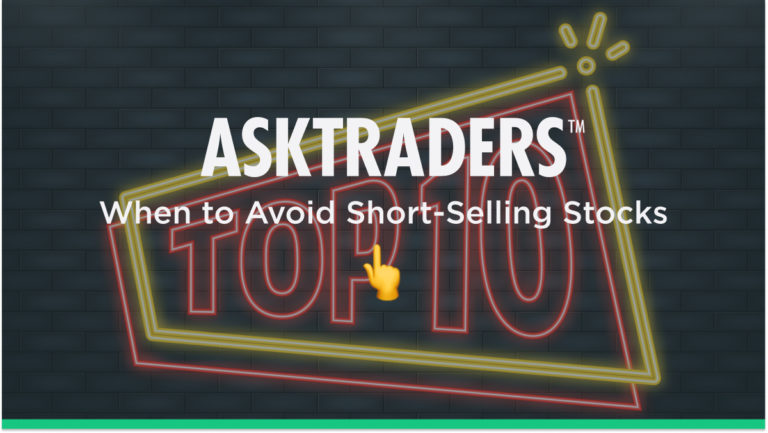
As outlined below, it takes more savvy to go short than long, and your risk is greater. Here is how short selling works and the psychological reasons you should steer clear of shorting shares. Here is a look at technical and fundamental analysis signals that warn you to venture away from shorting.
1. Avoid Shorting Stocks Trading Close to Key Moving Averages
If you use weekly charts, the 30-week moving average, invented as a trend tool by Stan Weinstein, should be the line you do not cross. Those using alternative time-frames might choose the 200-day moving average.
A stock will sometimes go above these key moving averages, shake off weak gains, and then rally again. It becomes too tricky at this point to short with any certainty. Besides, you can use moving averages in other strategies, such as the 52-week trading strategy and win.
Do not go short when the shares are markedly below this 200-day moving average.
2. Do Not Short Stocks With Strong Fundamentals
Like other areas of the financial markets, short-selling can become something of a craze. Stocks which are seen as ‘dogs' are widely shorted by traders who are following the lead of others rather than carrying out their own analysis.
In the case of GameStop, the US bricks-and-mortar video game store, there were plenty of reasons in 2020 to consider the company was heading toward going bust. At face value, the overheads of running its operations appeared uncompetitive in relation to online rivals. Still, those who carried out deeper fundamental analysis pointed to the firm having a fighting chance. As it turned out, the short-sellers of GME stock came unstuck when investor attitude towards the stock price performed a full-180 in January 2021 and doubled in value overnight.
3. Avoid shorting when the stock is in a clear uptrend
Does the stock have higher highs and higher lows for the last three swing points in a row? Although you can profit from any kind of trend in theory, pulling off a successful short in a clear upswing trend has to be one of the most challenging manoeuvres. The risk is significant even if the stock is hitting a price resistance line.
4. Steer clear of shorting volatile stocks
Biotechnology and other high-beta stocks are usually the ones to make a profit from when stock prices are bobbing up, down, and going sideways. You might make money if you time it right, but is it a good idea to opt for this level of high-risk exposure when other trading strategies that are easier to execute – and safer – abound? The problem with biotechnology stocks, in particular, is that they fall or rise unpredictably on the back of any industry-related reports, such as new research or clinical trials.
5. Avoid short-selling into confirmed bull-markets
Rule number one of investing is to trade in the same direction as the trend. After all, “the trend is your friend until the bend at the end”. Once momentum has built up, it takes a significant catalyst to cause it to ease off, and without that appearing, the long-term direction of travel will be upward. Trading the retracements, the short-term pull-backs when price consolidates is potentially profitable but inherently risky.
It's also essential to understand the general bias of equity markets. Historical data points to stock markets being characterised by long-term gradual increases in value, interspersed by infrequent and dramatic crashes. If you can time it right and short-sell into one of those crashes, then impressive profits can be made. But get the timing wrong, and you could be positioned incorrectly and facing a market which could continue heading north for months or years.
6. Don't scale up on shorts in high-margin stocks
Some stocks which are clearly overvalued can overshoot to the upside before correcting – and your analysis being proven correct. In other words, the period between opening a short position and price heading down can be unsettling for traders as a trade can initially make a loss. This situation can worsen if your trade position's size is too large or the stock you trade has high margin requirements.
Successful trading requires effective money management, and high-margin stocks that move against you can take up much of your capital. You'll be left with the option of cutting the position, even though you think it will ultimately come good or supporting it by ensuring extra collateral is placed in your account. That additional collateral can be generated by cutting other positions or a fresh injection of cash, but neither of those scenarios is ideal.
7. Don't short stocks where short-interest is a large percentage of daily trade volumes
Short squeezes are the ultimate nightmare for short-sellers. These events involve more than posting a loss on a bad position; they can wipe out entire accounts. One way to establish if there will be time to cover your short position if there is a race for the door is to consider the amount of existing short-interest in relation to daily trading volumes – the short interest ratio.
The greater the quantity of shorts, the longer it will take for short-sellers to close out positions without ‘hitting the bid' and causing price to ratchet up. Also, remember that trade volumes can ebb and flow in line with seasonal trends, such as national holidays or quiet summer markets.
8. Watch out for Regulators
Short selling is perfectly legal, most of the time. During moments of extreme market panic, regulators can adjust their stance and restrict short-selling in general or in specific sectors. It is done to protect those firms from going bust.
As soon as a regulator puts a cap on new short positions being opened, there is a real risk that the downtrend is over. It makes it technically hard for traders to act and sends an important message to the trading community that the party is over.
9. Can you cope with the notion of unlimited risk?
Unlimited risk is the game you are entering into when you short. There are times when the market can and will go against you for substantial periods.
If you use $1,000 to buy ten shares of company ABC which is priced at $100, your losses are capped at $1,000. If the price goes to zero, you're knocked out of the trade. In contrast, if you short ABC at a share price of $100 and it experiences a short-squeeze, then your losses would, in percentage terms, be 200% if the price reaches $300 per share. Examples of this happening are not as rare as you might imagine, and the Meme-stock craze of 2021 was founded on short squeezes on stocks like GameStop.
10. Avoid ‘naked' shorts if you can achieve downside exposure using safer instruments
The aim of a short-position is to make a return if a stock goes down. But what if there was a way to gain that same amount of exposure to a price correction but with less of the risk of a short-squeeze?
This is where options come in. Investors who buy Put Options have the right, but not the obligation, to sell the underlying stock at a specified price. There are time limits involved; for example, the expiry date on the option might be one, two or three months.
If the price of the underlying stock falls and trades below your strike price, then you'll show an unrealised profit until the expiry date, when any gains will be crystalised. A neat feature of options is that you can exercise them before the expiry date if you want, but that does short-change you to some extent as the ‘optionality' of the instruments has an intrinsic value. Alternatively, you can sell your ‘in the money' options directly to the market.
The only downside to using options is that the price paid for them, the premium, factors in the likelihood of an underlying stock tanking. The greater the risk, the higher the premium. On the other hand, the premium is a one-off cost, and if the price of the underlying skyrockets instead, you can just let your options expire worthlessly, and your losses are capped at the premium paid.
Shorting stocks using CFDs involves paying daily financing charges, which can stack up over time, so the relative cost of trading using options might not be as much of a disadvantage as first thought, particularly as the risks of a short-squeeze are eliminated.
Final Thoughts
Not all trades are winners. Some of your short trades will end up being loss-making but applying effective risk management can help manage the downside and hopefully allow your win-loss ratio to, over time, be better than 50-50.
The real risk with short-selling is getting caught in a short squeeze. They can wipe out the accounts of even the most experienced investors, including multi-billion-dollar hedge funds. That is part of the reason that short selling for some time remained a tool limited to professional traders working for big institutional firms.
Online trading platforms such as those found on this shortlist of trusted brokers offer short-selling and back it up with risk management tools and other resources that can help you profit when markets are falling. Given the increased uncertainty caused by the stock market sell-off of 2022, it is worth considering the ways to make a profit in a falling market, but as with all trading, careful planning is required.




